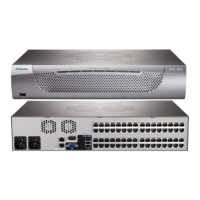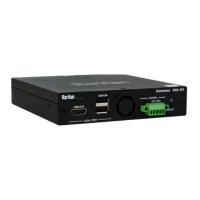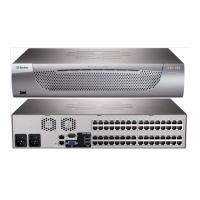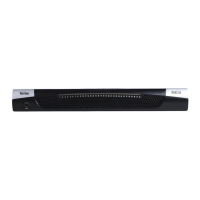Do you have a question about the Raritan II and is the answer not in the manual?
Describes the Paragon II KVM matrix switching system architecture.
Visuals of the Paragon II base units, user stations, and CIMs.
Lists the key capabilities and specifications of the Paragon II system.
Details the items included with each Paragon II component.
Step-by-step guide for initial setup of the Paragon II system.
Verifies server viewing and control through the Paragon system.
Details the control buttons and LCD display functions on the unit.
Instructions for setting up the Paragon system for the first time.
Guide for setting up a system with one Paragon Base Unit.
Instructions for expanding capacity by linking multiple base units.
Details the process of connecting a stacking switch to expand ports.
Procedure to log on and access servers via the Paragon II system.
How to choose and connect to a specific server from the selection menu.
Allows users to set preferred operating parameters and manage their profiles.
Displays function keys and their corresponding help functions.
Lists function keys for accessing OSUI features and their purposes.
Displays vital statistics of the User Station and connected Base Unit.
Access point for administrators to manage system configuration and user privileges.
Recommendations for modifying system administration settings.
Setting global parameters for the Paragon II system.
Manages user accounts, security rights, and connection status.
Editing or initializing P2CIM-PS2, changing device names and settings.
Setting global keyboard type and video delay for user stations.
Assigning access rights to users and CPUs via group IDs.
Configuring IP address, Net Mask, Gateway, and other network parameters.
Controls automatic switching between channel ports and skipping vacant ones.
Controls power to connected devices via Raritan Remote Power Control Units.
Managing power for devices connected to power strips.
How to connect Z-Series Z4200U CIMs as tiers in the system.
Steps to set up an IBM x330 rack as a second tier device.
Guidelines for power recycling after connection changes in tiered devices.
Explains different ways to build multi-level device architectures.
Covers standard methods for arranging devices in tiers.
Definition and constraints for a single base unit configuration.
How to expand channel ports using stacking switches.
Examples of non-blocked systems using stacking.
Describes configurations requiring special procedures or not fully supported.
Procedures for non-standard configurations with older firmware.
Specific procedure for implementing a triangle configuration.
Specific procedure for implementing a diamond configuration.
Procedure for setting up a redundant system for higher availability.
Optimal connection layout for redundant systems.
Identifies unsupported configurations to avoid.
Warns against dead-loop setups causing database conflicts.
Lists technical specifications for Paragon II components.
How to connect a User Station directly to a CIM for emergency access.
Details compatibility between different hardware and firmware versions.
Instructions for mounting Paragon II units in a standard equipment rack.
Steps for mounting units facing the front of the rack.
Steps for mounting units facing the rear of the rack.
Guide to using the AUATC for RS-232 serial device access.
Overview of the AUATC's features and capabilities.
Steps for attaching the AUATC to a server and Paragon system.
How to use the AUATC in its various modes.
Description of the AUATC's on-screen interface elements.
Accessing help information within the AUATC interface.
Editing and reviewing data stored in the AUATC buffer.
Setting serial communication parameters and video output.
Programming function keys for sending commands to devices.
Common issues and solutions for AUATC operation.
How to emulate Sun keyboard keys using a PS/2 keyboard.
Lists symptoms and probable causes for Paragon II issues.
Critical order for powering on devices in multi-tier configurations.
Frequently asked questions about Paragon II features and compatibility.
Describes the Paragon II KVM matrix switching system architecture.
Visuals of the Paragon II base units, user stations, and CIMs.
Lists the key capabilities and specifications of the Paragon II system.
Details the items included with each Paragon II component.
Step-by-step guide for initial setup of the Paragon II system.
Verifies server viewing and control through the Paragon system.
Details the control buttons and LCD display functions on the unit.
Instructions for setting up the Paragon system for the first time.
Guide for setting up a system with one Paragon Base Unit.
Instructions for expanding capacity by linking multiple base units.
Details the process of connecting a stacking switch to expand ports.
Procedure to log on and access servers via the Paragon II system.
How to choose and connect to a specific server from the selection menu.
Allows users to set preferred operating parameters and manage their profiles.
Displays function keys and their corresponding help functions.
Lists function keys for accessing OSUI features and their purposes.
Displays vital statistics of the User Station and connected Base Unit.
Access point for administrators to manage system configuration and user privileges.
Recommendations for modifying system administration settings.
Setting global parameters for the Paragon II system.
Manages user accounts, security rights, and connection status.
Editing or initializing P2CIM-PS2, changing device names and settings.
Setting global keyboard type and video delay for user stations.
Assigning access rights to users and CPUs via group IDs.
Configuring IP address, Net Mask, Gateway, and other network parameters.
Controls automatic switching between channel ports and skipping vacant ones.
Controls power to connected devices via Raritan Remote Power Control Units.
Managing power for devices connected to power strips.
How to connect Z-Series Z4200U CIMs as tiers in the system.
Steps to set up an IBM x330 rack as a second tier device.
Guidelines for power recycling after connection changes in tiered devices.
Explains different ways to build multi-level device architectures.
Covers standard methods for arranging devices in tiers.
Definition and constraints for a single base unit configuration.
How to expand channel ports using stacking switches.
Examples of non-blocked systems using stacking.
Describes configurations requiring special procedures or not fully supported.
Procedures for non-standard configurations with older firmware.
Specific procedure for implementing a triangle configuration.
Specific procedure for implementing a diamond configuration.
Procedure for setting up a redundant system for higher availability.
Optimal connection layout for redundant systems.
Identifies unsupported configurations to avoid.
Warns against dead-loop setups causing database conflicts.
Lists technical specifications for Paragon II components.
How to connect a User Station directly to a CIM for emergency access.
Details compatibility between different hardware and firmware versions.
Instructions for mounting Paragon II units in a standard equipment rack.
Steps for mounting units facing the front of the rack.
Steps for mounting units facing the rear of the rack.
Guide to using the AUATC for RS-232 serial device access.
Overview of the AUATC's features and capabilities.
Steps for attaching the AUATC to a server and Paragon system.
How to use the AUATC in its various modes.
Description of the AUATC's on-screen interface elements.
Accessing help information within the AUATC interface.
Editing and reviewing data stored in the AUATC buffer.
Setting serial communication parameters and video output.
Programming function keys for sending commands to devices.
Common issues and solutions for AUATC operation.
How to emulate Sun keyboard keys using a PS/2 keyboard.
Lists symptoms and probable causes for Paragon II issues.
Critical order for powering on devices in multi-tier configurations.
Frequently asked questions about Paragon II features and compatibility.











